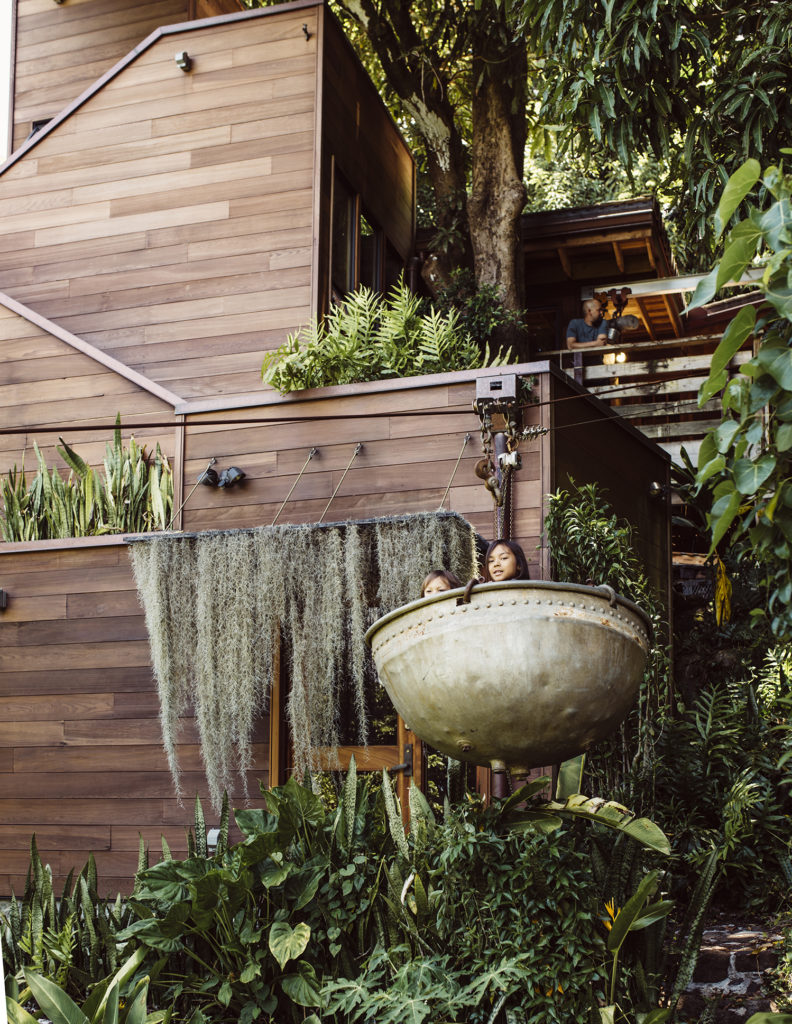Text and images by IJfke Ridgley
Tucked deep in the recesses of Pālolo Valley, where clouds hang over green creases of jungle infringing upon twisted streets, sits a house hidden high in the foliage. To reach it, you must enter the property at the bottom of a steep hill and climb a long flight of stone pavers through ferns and heliconia.
Gazing up from the end of the path at reclaimed redwood dripping with flora—Spanish moss hanging in front of windows, acting as natural sunscreens—it is hard to tell where house ends and forest begins. That is exactly the point.
When architect Aaron Ackerman bought this plot in 2011, his wife, Jessica, was pregnant with their first child, and they ambitiously set out to build a green home, a living space in sync with its environment. They fixed up and moved into a humble structure on the property and spent the next few years studying the land: the vegetation, topography, and where the water went when it rained. It wasn’t until four years later that they started construction on the home they imagined, using this data to inform how and where they built.
The site, like any structure evocative of a treehouse, is a child’s dream. The couple’s three children, who are aptly named for the three elements found in every woody plant—Xylem, Cambium, and Phloem—hang out in nets high in the trees. The home has a zipline winch system that looks like a prop out of Hook, featuring a repurposed WWII Marine cauldron from Maui found buried on the property as a carrying container, which Ackerman installed to haul a 500-pound stone birthing tub up to the house. Of the house’s building materials, 75 percent are salvaged or reused.

Ackerman has worked as an architect and sustainability facilitator at Bowers and Kubota for going on 18 years. This might be the firm’s most ambitious project yet. Its name is Haleola‘ili‘āinapono, an amalgamation of the Hawaiian ideas of a living house (hale ola) managed by an individual for the betterment of the community (‘ili ‘āina) in a morally conscious way (pono).
The purpose of this house is to raise the bar for what people consider an environmentally friendly building.
“How we live has an impact, and we spend, on average, 90 percent of our time indoors,” he says. “That means that we are very impacted by the buildings that we occupy.” There have been LEED-certified developments in Hawai‘i before, but Ackerman built his house based on the much more stringent set of standards outlined in the Living Building Challenge.
Created by the International Living Future Institute, the Living Building Challenge consists of 20 imperatives a building must fulfill to receive Living Building certification. The criteria are challenging, including sourcing the majority of its materials locally, generating all of the building’s energy from renewable resources, and using rain catchment for all its water, with all wastewater and stormwater reused for urban agriculture or groundwater recharge. In short, a building that passes this test aims to do more than just save some energy—it aims to have a net-positive impact, giving back more to the land than it takes.
While the home is well equipped with state-of-the-art appliances and devices, the project’s real innovation is its symbiotic relationship with nature. The roof is vegetated with laua‘e ferns to absorb stormwater and keep the house cool. Wastewater from the toilets and kitchen sink is treated aerobically and then used for subsurface irrigation of nonedible plants, including the a‘e tree (Hawaiian soap berry), whose berries can be used as a laundry detergent. Greywater is stored under the house for future use after any heat it retains is extracted to heat new water. Collected rainwater is used for everything from drinking water and showers to irrigation for the more than 25 varieties of fruit trees on the property, including lychee, macadamia nut, coffee, and mango.
You May Also Like: A Living Legacy





Some of the parameters of the Living Building Challenge are harder to measure than others. To Ackerman, it’s these qualitative imperatives that are the most important. Biophilia, for example, is the innate human tendency to seek connections with nature; to meet the Living Building Challenge’s biophilic design imperatives, he employed natural ventilation and biomorphic forms to echo the surrounding environment.
“The house is an experience,” he says. “It offers perspective, sanctuary, mystery, and risk. As you are experiencing the house, it draws you around the next corner. You never really see the whole thing.”
After years of work by the Bowers and Kubota team and with assistance from donors and partners, the house was completed at the end of 2019. The team is now working to finance the last phase of the project: a solar structure that will generate enough renewable energy to support the property on an annual basis and offer enough battery energy storage to support up to a week of refrigeration in the event of a power disturbance. The structure will double as a rainwater catchment system and carport, and Ackerman hopes to have it installed and operational by mid-2023.
If, after its performance period, the project passes Living Building certification, it will be the first residence of its kind in Hawai‘i. (The Energy Lab at Hawai‘i Preparatory Academy is a certified Living Building.) Homes like these are not only an answer to local environmental issues such as cesspool pollution, freshwater shortages, and declining landfill capacity from construction waste, but they are also an invitation to live in greater harmony with the land.


Ackerman believes the human desire for connection with the natural world is the driving force behind Living Buildings, and what will ultimately inspire others to live more sustainably.
“Solar panels don’t inspire humans,” he says. “Humans are inspired by nature, and they respond positively—mentally, spiritually, physically—to an enhanced relationship with nature. This is the utopic feeling people get when they experience a building like this.”





